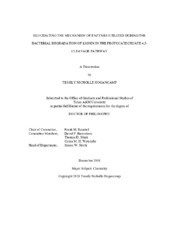| dc.contributor.advisor | Raushel, Frank M | |
| dc.creator | Hogancamp, Tessily Nicholle | |
| dc.date.accessioned | 2020-08-26T16:48:23Z | |
| dc.date.available | 2020-08-26T16:48:23Z | |
| dc.date.created | 2019-12 | |
| dc.date.issued | 2019-10-21 | |
| dc.date.submitted | December 2019 | |
| dc.identifier.uri | https://hdl.handle.net/1969.1/188745 | |
| dc.description.abstract | Lignin is the most abundant renewable aromatic in the world that has great potential as a sustainable source of monomeric units for the production of bioplastics. However, the chemical and biological processing of lignin in industry is difficult due to the heterogeneity of the polymer structure. The natural recycling of lignin occurs through depolymerization by oxidoreductases secreted by fungi. Many bacterial pathways metabolize these lignin oligomers into small carbon fragments which are used in the TCA cycle. Many of the known enzymatic pathways funnel to protocatechuate (PCA) that can be further metabolized by three cleavage pathways. Our goal is to decipher the mechanistic details of the PCA 4,5-cleavage pathway from the Sphingomonas sp. SYK-6. The enzymes LigU, LigJ, and LigK play an important role in the degradation, but have not been structurally or mechanistically characterized. Using NMR spectroscopy, LigU was shown to function as a 1,3-allylic isomerase where the double bond between C5-C4 of (4E)-oxalomesaconate (OMA) migrates to C4-C3 forming (3Z)-2-keto-4- carboxy-3-hexenedioate (KCH). LigU was further characterized to show that the stereospecific proton transfer at C5 of KCH is proS and that Lys-66 and Cys-100 are critical catalytic residues. We recently determined the structure of wild-type LigU and the ligand-bound complex of the mutant LigU K66M by X-ray crystallography.
The ligand-bound structure also shows that the two catalytic residues are on the same face of the ligand to support a syn-fashion reaction. We also determined the three-dimensional structures of the LigJ hydratase. The structure of the product bound complex shows that CHA, 4-carboxy-4-hydroxy-2-oxoadipate is formed in the S-configuration. The mutant E284Q has no observable catalytic activity and this mutant was used to co-crystallize the substrate, KCH with LigJ. Based on the kinetic parameters and the structure of the bound substrate in the active site, we propose that Glu-284 acts as both the catalytic base and acid in an overall syn-addition. My future work will focus on characterizing the C-C cleavage of LigK aldolase by site-directed mutagenesis and monitoring changes in activity. Also, attempts at co-crystallization of mutants with substrate and substrate analogs are ongoing to determine the active site chemistry. | en |
| dc.format.mimetype | application/pdf | |
| dc.language.iso | en | |
| dc.subject | lignin | en |
| dc.subject | metabolism | en |
| dc.subject | bacterium | en |
| dc.subject | Sphingobium sp. SYK-6 | en |
| dc.subject | protocatechuate | en |
| dc.subject | LigU isomerase | en |
| dc.subject | LigJ hydratase | en |
| dc.subject | proton carbon NMR spectroscopy | en |
| dc.subject | X-ray crystallography | en |
| dc.subject | mechanism | en |
| dc.subject | stereochemistry | en |
| dc.subject | site-directed mutagenesis | en |
| dc.subject | bioproducts | en |
| dc.title | Elucidating the Mechanism of Enzymes Utilized During the Bacterial Degradation of Lignin in the Protocatechuate 4,5-Cleavage Pathway | en |
| dc.type | Thesis | en |
| thesis.degree.department | Chemistry | en |
| thesis.degree.discipline | Chemistry | en |
| thesis.degree.grantor | Texas A&M University | en |
| thesis.degree.name | Doctor of Philosophy | en |
| thesis.degree.level | Doctoral | en |
| dc.contributor.committeeMember | Barondeau, David P | |
| dc.contributor.committeeMember | Meek, Thomas D | |
| dc.contributor.committeeMember | Watanabe, Coran MH | |
| dc.type.material | text | en |
| dc.date.updated | 2020-08-26T16:48:24Z | |
| local.etdauthor.orcid | 0000-0002-7610-1217 | |


